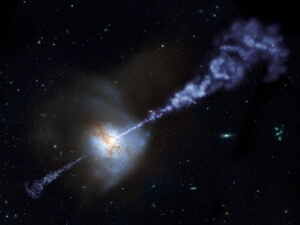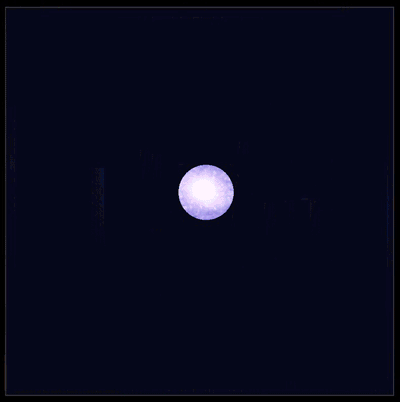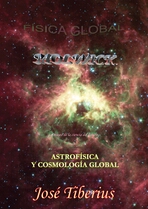1.b.2. Supermassive black balls and the origin of the galaxies
In the previous section, we have shown an overview of the concept, formation, types and main effects of black holes. To simplify the analysis and comparison, we will maintain a similar structure here.
This second section contains proposals from Global Astrophysics regarding the concept, origin, characteristics, and effects of supermassive black holes (SMBH) or supermassive black balls, given that they can be significantly different due to their enormous size.
We remind the reader that Global Physics, an interpretation of General Relativity and Quantum Mechanics, is a bold theory, particularly when it comes to Global Astrophysics –while not quite at the extreme level of Modern Physics.
In the real developments are mixed processes, and there are all the exceptions to the general case we can imagine. In some way, we must imagine or discover the forces present in all cases, although they may not always be the determinants of the observed result.
Concept
The supermassive black balls are, as their name indicates, those having much mass; so much, like millions or billions the mass of the Sun.
It seems that they typically exist at the center of galaxies and are also known as active galactic centers or quasars in the case of being active.
-
Formation
The general idea we all have so far is the formation due to gravity that would join the cosmic dust in asteroids, planets, stars, neutron stars, black balls and, finally, supermassive black balls.
For Global Physics, these slow processes may be appropriate in the cases above except for that of supermassive black balls for the following reasons:
The expansion of the Universe causes the stars in the big galaxies to be moving away from the center instead of approaching.
The origin of the immense amount of cosmic dust needed is not clear, much less bearing in mind its spatial distribution capable of generating observed galaxies.
On the contrary, it seems that there had to be an initial explosion that caused at least the local universe –Little Bang– and that some stars and black holes formed almost at the beginning or directly.
With few exceptions, the supermassive black balls would have formed directly or in a fast initial process. Although this idea is the opposite to create from stars, NASA on its page about massive black holes in the early universe ** says, “why are there so many supermassive black holes in the early universe?”
Characteristics and effects
Supermassive black balls have additional characteristics to those of smaller black holes and, therefore, produce different effects:
Composition and internal structure
Their enormous size and the high internal gravity force could provoke rigid structures of nucleons, and that these structures behave as oversize particles.
Simple Physics experiment
We can visualize these giant structures if we think of a three-dimensional elastic net with small marbles in its reticules; we grab a few of these with our hand and twist our fist.
Emission of mass and electromagnetic energy
There is evidence that supermassive black balls expel large numbers of particles jets of mass and electromagnetic energy, possibly due to their speed of rotation. **
Black hole jet (Public domain image) 
Some large clouds of intergalactic dust could have their origin in supermassive black balls. The page on the phenomenon called Ram-pressure stripping ** states: “The high incidence of nuclear activity among heavily stripped jellyfish galaxies may be due to ram pressure causing gas to flow towards the center and triggering the activity, or to an enhancement of the stripping caused by energy injection from the active nucleus, or both.”
Another example to ponder would be this article about a source of cosmic dust. **
This effect would be different from that of the quasars or active galactic centers, where the emission of electromagnetic energy is due to the heating and loss of mass of the cosmic dust disk.
Powerful electromagnetic fields
It seems scientists thought gravitational processes were more relevant in the formation of stars than electromagnetic processes. However, lately, some studies show maps of the galactic and intergalactic magnetic field and powerful magnetic field ** around black holes indicating that these fields play a more significant role than previously thought.
It is convenient to distinguish between observations and simulations ** because any model recreation will behave as programmed.
Global Astrophysics does not deny gravitational processes, but it also gives significance to electromagnetic fields; by the processes explained in the section on Elementary particles and constitution of the mass of book Global Mechanics, regardless of whether stars eject cosmic dust in supernova-like explosions.
Creation of a large part of the primary stars
Taking into account the rotation of the galaxy and the expansion of the universe, the arms of the spiral galaxies seem to be a consequence of a continuous birth of stars near the galactic center.
As the rate of star creation does not seem to have declined much over time, the birth of primary stars over billions of years implies the existence of a continuous nourishing of cosmic dust.
Expansion of the universe as an indirect effect
The supermassive black balls seem to be the foremost source of the creation of cosmic dust for the birth of the primary stars, either by direct ejection or by creation due to the enormous electromagnetic fields they generate.
Formation of the galaxies
Global Physics GIF animated - CC0 Creative Commons
Besides, the stars will produce the expansion of the Universe both with the emission of electromagnetic energy because of the decompression of the reticular matter in the nuclear reactions, as well as the decompression of the Global Aether itself.
Therefore, the supermassive black balls have an indirect effect due to the expansion of the universe caused by nuclear fusion in the created stars.
-
The shock of supermassive black balls
In the previous section, we also mentioned that shocks of black holes are relatively numerous given the amount that can exist in the same galaxy. However, the same does not happen with supermassive black balls.
An interesting topic would be the fusion of two supermassive black balls, one right-handed and the other left-handed, which could produce a small Big Bang or Little Bang.
It is difficult for two supermassive black balls of a different spatial nature to exist close to each other or even within the local or observable universe since the forces that originate them would compensate, and no such supermassive black balls could arise.
However, in larger scales cannot be ruled out that they come into existence and that, once created and neutralized part of the torsional forces, such as a giant ball of elastic rubber balls, could approach, collide and, given its different nature, explode violently.
